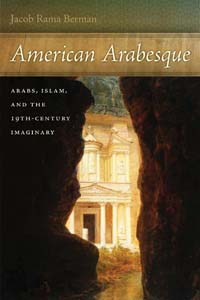By Lynne Rogers
American Arabesque, Arabs, Islam and the 19th Century Imaginary
By Jacob Rama Berman
New York University Press, 2012
Jacob Rama Berman begins his erudite “American Arabesque, Arabs, Islam and the 19th Century Imaginary” with one of his many fascinating and little known cross cultural Arab American anecdotes about the Syrian American, Hi Jolly, who becomes one of the first U.S. Army camel drivers, and later retires with his pet camels to Quartzite, Arizona. Well versed in both Arab and American literary traditions, Berman examines the manipulation of the “Arab” or Bedouin to create a “racial map” of 19th century American culture.
Consistently drawing attention to the current relevance of this manipulation of the “Arab,” Berman recounts how the rather dubious 1805 American intervention in Tripoli establishes a precedent of using military action as an “expression of America’s commitment to freedom and democracy.” By way of contrast, Irish American diplomat and former Barbary pirate captive and freed Algerian slave, James Leander Cathcart, reaffirms American self-righteous patriotism by emphasizing the chaos and brutality of the North African country of Algiers. At the time of the American passage of the Indian Removal Act, New Yorker, John Lloyd Stephens characterizes the Bedouins as Native Americans in his travel journals.
With impressive scholarly dexterity, Berman compares American conflation of the Native American with the Bedouin as a means of creating an historical narrative with 14th century Arab writer, Ibn Khaldun’s, discussion of the Bedouin as a contrast to urban progress. Berman then charts several American cultural references, from artwork and female travel journals to Melville, that borrow the Biblical narrative as a paradigm for American imperialism and cite the interest in Petra as a reminder of the folly of grand commercial optimism.
While Berman’s writing can be formidably dense, he offers a wealth of cross-cultural examples and currents that beg further exploration. His chapter on Edgar Allen Poe, alone, rushes from references of 20th century American poetry to contemporary and ninth century Arabic poetry, as well as the French Symbolists, and finally concludes with a comparison of Poe’s short story “Ligeia,” with its Sufi mysticism. In Poe’s terrifying refashioning of Arab décor and images, he divests the arabesque of any religious or cultural significance and “reinvests it with secular anxieties about individuality, distinction, uniqueness, and/or sovereignty.”
In his chapter “American Moors and the Barbaresque,” Berman explores how the fluid figure of the “Moor” plays out in the fascinating and contrasting historical narratives of Black America. Establishing the Moorish Science Temple around the same time as the Harlem Renaissance, Noble Drew Ali preaches that the black man in America descends from the Moors of Morocco, thereby establishing a positive origin narrative rooted in something other than slavery. At one point before his mysterious death, Drew Ali, an accused plagiarist, and peddler of healing mineral oil, attracts 30,000 followers with his appeal to Blacks looking to Islam as a religious and political alternative to white Christianity. Berman borrows Caribbean poet Claude McKay’s term “Babaresque,” examining both McKay’s and DuBois’ ambiguous responses to interracial relations with North Africans. In a wonderful and logical bit of scholarship that would startle the sleepiest student Berman suggests that Muslims, still faithful at heart to their original religion despite being forcibly converted to Christianity, travel with Christopher Columbus on his voyage to the New World
Berman concludes his study with the ethnic performative role of Arab identity for the Syrian immigrants and inspires one to reread Ameen Rihani and Vance Bourjaily. From the Arab street urchin, a figure of Protestant redemption, to the iterant peddler, Syrians can choose to ‘wash away’ their “Arabness” or reclaim and enhance their ‘exoticism’ as a self-marketing strategy.
While reading Berman will provide challenges for the uninitiated reader, he opens an array of topics that demands further study and contains some historical and literary gems. If I were still a graduate student, I would run to the library to order “American Arabesque, Arab, Islam and the 19th Century Imaginary.”
This article appeared in Al Jadid Magazine, Vol. 18, No. 67, 2013-2014.
Copyright © 2014 AL JADID MAGAZINE

